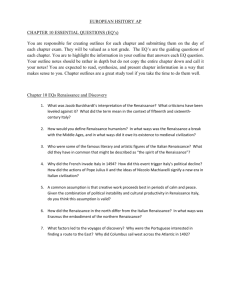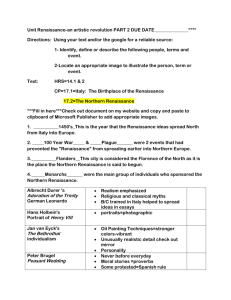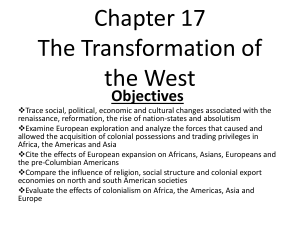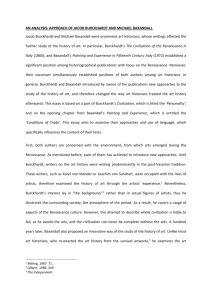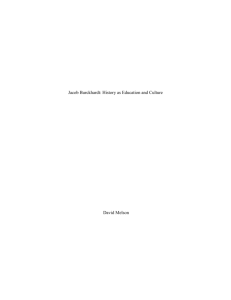Proposal
advertisement
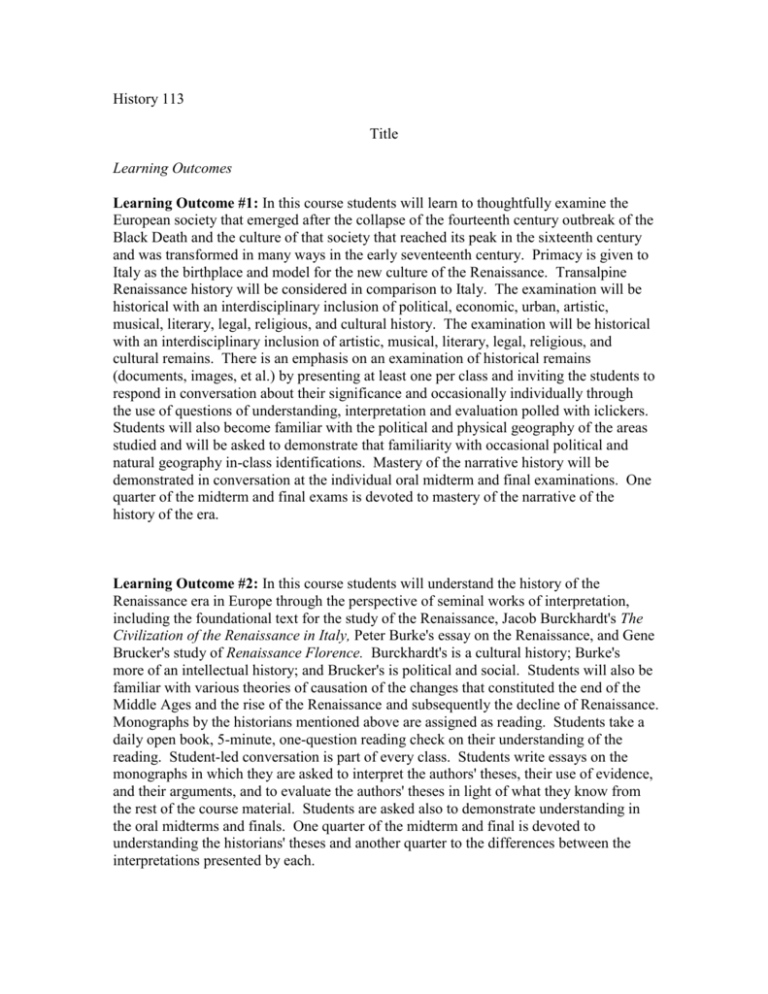
History 113 Title Learning Outcomes Learning Outcome #1: In this course students will learn to thoughtfully examine the European society that emerged after the collapse of the fourteenth century outbreak of the Black Death and the culture of that society that reached its peak in the sixteenth century and was transformed in many ways in the early seventeenth century. Primacy is given to Italy as the birthplace and model for the new culture of the Renaissance. Transalpine Renaissance history will be considered in comparison to Italy. The examination will be historical with an interdisciplinary inclusion of political, economic, urban, artistic, musical, literary, legal, religious, and cultural history. The examination will be historical with an interdisciplinary inclusion of artistic, musical, literary, legal, religious, and cultural remains. There is an emphasis on an examination of historical remains (documents, images, et al.) by presenting at least one per class and inviting the students to respond in conversation about their significance and occasionally individually through the use of questions of understanding, interpretation and evaluation polled with iclickers. Students will also become familiar with the political and physical geography of the areas studied and will be asked to demonstrate that familiarity with occasional political and natural geography in-class identifications. Mastery of the narrative history will be demonstrated in conversation at the individual oral midterm and final examinations. One quarter of the midterm and final exams is devoted to mastery of the narrative of the history of the era. Learning Outcome #2: In this course students will understand the history of the Renaissance era in Europe through the perspective of seminal works of interpretation, including the foundational text for the study of the Renaissance, Jacob Burckhardt's The Civilization of the Renaissance in Italy, Peter Burke's essay on the Renaissance, and Gene Brucker's study of Renaissance Florence. Burckhardt's is a cultural history; Burke's more of an intellectual history; and Brucker's is political and social. Students will also be familiar with various theories of causation of the changes that constituted the end of the Middle Ages and the rise of the Renaissance and subsequently the decline of Renaissance. Monographs by the historians mentioned above are assigned as reading. Students take a daily open book, 5-minute, one-question reading check on their understanding of the reading. Student-led conversation is part of every class. Students write essays on the monographs in which they are asked to interpret the authors' theses, their use of evidence, and their arguments, and to evaluate the authors' theses in light of what they know from the rest of the course material. Students are asked also to demonstrate understanding in the oral midterms and finals. One quarter of the midterm and final is devoted to understanding the historians' theses and another quarter to the differences between the interpretations presented by each. Learning Outcome #3: In this course, students will learn how to research, analyze, and present questions in Renaissance history. Research work will be practiced in the daily preparation of discussion leadership and in the preparation of a major lesson for the second half of the course. Primary documentary evidence, in translations, art, artifacts, and music, will be offered as part of the lecture of each class. The students' research work will be mainly, but not solely for a major lecture—of twenty minutes—that every student will give on a topic of their choice. The work of research for the lecture will involve guidance in the search for primary and secondary sources, reporting of sources, and creating a bibliography. Students at the beginning of the course are given a guide sheet for the research with avenues of research in the library, through interlibrary loan (Link+ and Illiad), and online. Students are also presented with a lecture on the cautions of using Wikipedia and the ways of evaluating online resources. Students then submit a preliminary bibliography on the way to completing their research. Every bibliography must include a predominance of print sources. When students make their presentation they must distribute their bibliography to the class and in Q&A they are responsible for commenting on the uses of their sources. The same skills of research and gathering of data emphasized for the preparation of a major lesson are enjoined on the students as they prepare and take part in the daily leading of discussion of the readings. A student leader is asked to state three major points from the assigned reading, supply background information that he help the class understand the reading, and then pose a question or series of questions to help initiate the conversation. Learning Outcome #4: In this course, students will understand the meaning of humanism in its Renaissance context. Students will also understand the major developments in the visual arts and architecture and be able to relate those developments to the themes of Renaissance humanism. They will do this through daily writing on and discussion of the readings with a focus on critical analysis of the authors' work of selection and interpretation of evidence; interpretive essays, preparation and delivery of twenty-minute lesson, and oral one-on-one midterm and final examinations that revolve around the students' abilities to bring all of the coursework together into an interpretive whole. The five-minute, open-book daily reading checks establish a regular communication between the professor and the individual student whereby I can track their understanding. The work on the lesson that students present enables the student to demonstrate the depth and sophistication of understanding. The essays are a primary means of showing the ability to interpret the material. Students must analyze an assigned author's thesis and methodology, major school of interpretation (whether cultural, intellectual, or economic), and the success of the thesis. They are also asked in the second and subsequent essays to compare and contrast historians. The oral exams complement the work of the essay writing in allowing the student to demonstrate the same learnings in conversation. In all these ways, students will learn how to interpret evidence about the social, political, intellectual, and cultural history of the Renaissance. Syllabus, with parenthetical applications of goals. [See the annotated syllabus for this and the subsequent material.] Course Requirements Grade Evaluation Student Disability Services, etc...


